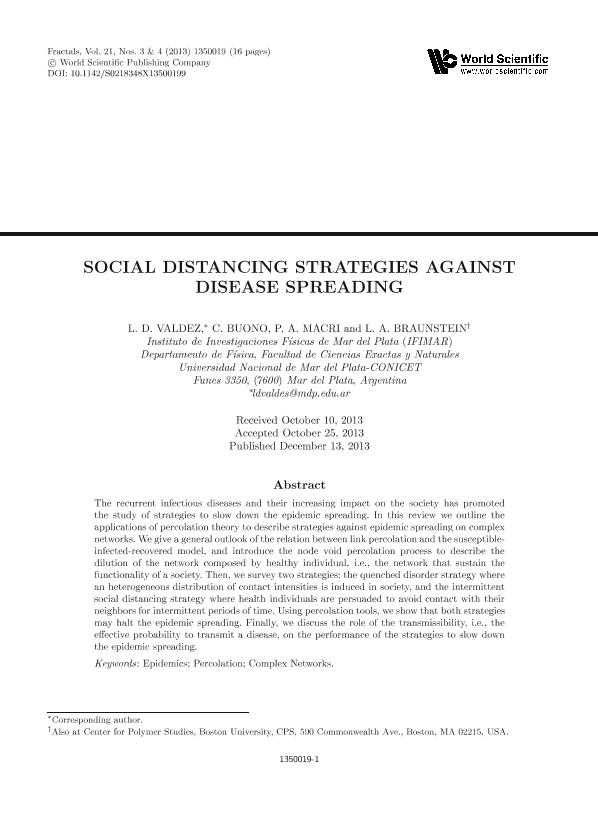Mostrar el registro sencillo del ítem
dc.contributor.author
Valdez, Lucas Daniel

dc.contributor.author
Buono, Camila

dc.contributor.author
Macri, Pablo Alejandro

dc.contributor.author
Braunstein, L. A.
dc.date.available
2016-11-15T19:20:58Z
dc.date.issued
2013-12
dc.identifier.citation
Valdez, Lucas Daniel; Buono, Camila; Macri, Pablo Alejandro; Braunstein, L. A.; Social distancing strategies against disease spreading; World Scientific; Fractals; 21; 3; 12-2013; 1350019-1350035
dc.identifier.issn
0218-348X
dc.identifier.uri
http://hdl.handle.net/11336/8242
dc.description.abstract
The recurrent infectious diseases and their increasing impact on the society has promoted the study of strategies to slow down the epidemic spreading. In this review we outline the applications of percolation theory to describe strategies against epidemic spreading on complex networks. We give a general outlook of the relation between link percolation and the susceptible-infected-recovered model, and introduce the node void percolation process to describe the dilution of the network composed by healthy individual, i.e., the network that sustain the functionality of a society. Then, we survey two strategies: the quenched disorder strategy where an heterogeneous distribution of contact intensities is induced in society, and the intermittent social distancing strategy where health individuals are persuaded to avoid contact with their neighbors for intermittent periods of time. Using percolation tools, we show that both strategies may halt the epidemic spreading. Finally, we discuss the role of the transmissibility, i.e., the effective probability to transmit a disease, on the performance of the strategies to slow down the epidemic spreading.
dc.format
application/pdf
dc.language.iso
eng
dc.publisher
World Scientific

dc.rights
info:eu-repo/semantics/openAccess
dc.rights.uri
https://creativecommons.org/licenses/by-nc-sa/2.5/ar/
dc.subject
Epidemics
dc.subject
Percolation
dc.subject
Networks
dc.subject.classification
Otras Ciencias Físicas

dc.subject.classification
Ciencias Físicas

dc.subject.classification
CIENCIAS NATURALES Y EXACTAS

dc.title
Social distancing strategies against disease spreading
dc.type
info:eu-repo/semantics/article
dc.type
info:ar-repo/semantics/artículo
dc.type
info:eu-repo/semantics/publishedVersion
dc.date.updated
2016-11-14T19:32:10Z
dc.journal.volume
21
dc.journal.number
3
dc.journal.pagination
1350019-1350035
dc.journal.pais
Singapur

dc.description.fil
Fil: Valdez, Lucas Daniel. Consejo Nacional de Investigaciones Científicas y Técnicas. Centro Científico Tecnológico Mar del Plata. Instituto de Investigaciones Físicas de Mar del Plata; Argentina
dc.description.fil
Fil: Buono, Camila. Consejo Nacional de Investigaciones Científicas y Técnicas. Centro Científico Tecnológico Mar del Plata. Instituto de Investigaciones Físicas de Mar del Plata; Argentina
dc.description.fil
Fil: Macri, Pablo Alejandro. Consejo Nacional de Investigaciones Científicas y Técnicas. Centro Científico Tecnológico Mar del Plata. Instituto de Investigaciones Físicas de Mar del Plata; Argentina
dc.description.fil
Fil: Braunstein, L. A.. Consejo Nacional de Investigaciones Científicas y Técnicas. Centro Científico Tecnológico Mar del Plata. Instituto de Investigaciones Físicas de Mar del Plata; Argentina
dc.journal.title
Fractals

dc.relation.alternativeid
info:eu-repo/semantics/altIdentifier/doi/http://dx.doi.org/10.1142/S0218348X13500199
dc.relation.alternativeid
info:eu-repo/semantics/altIdentifier/url/http://www.worldscientific.com/doi/abs/10.1142/S0218348X13500199
dc.relation.alternativeid
info:eu-repo/semantics/altIdentifier/url/https://arxiv.org/abs/1308.2009v1
Archivos asociados
